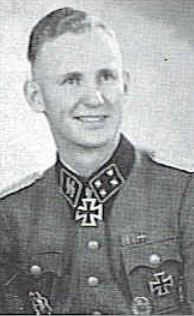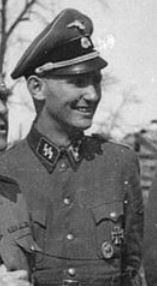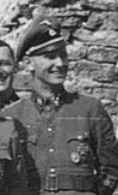Meyer, Hans (Waffen SS)
- Date of birth:
- September 13th, 1916 (Kiel, Germany)
- Date of death:
- March 22nd, 1979 (Munich, Germany)
- Service number:
- SS-Nr.: 311.794 // NSDAP-Nr.:
- Nationality:
- German (1933-1945, Third Reich)
Biography
25.05.1933-01.10.1933: Hitlerjugend
01.10.1933-01.04.1936: NAPOLA, Plon
01.04.1936-10.10.1936: RAD
00.10.1936: Pionier-Bataillon, Reichswehr
00.09.1937: joined the SS in the SS-Standarte "Deutschland", SS-VT
01.10.1937-01.08.1938: SS-Junker, SS-Junkerschule Bad Tölz
00.09.1938: Zugführer-Lehrgang, Dachau
25.10.1938: SS-Standartenoberjunker, 10. Kompanie, SS-Infanterie-Regiment-"Deutschland"
00.09.1939: WIA two times during the Polish campaign and sent to a Lazarett SS-Heim Karlsbad
00.11.1939: SS-Ostuf, SS-Infanterie-Ersatz-Bataillon, LSSAH
18.09.1941: SS-Ostuf, WIA for the 3rd time
25.10.1941: SS-Ostuf, Regiments-Adjutant, SS-Infanterie-Regiment "Nordland", 5. SS-Panzer-Division 'Wiking'
00.12.1941: SS-Ostuf, Führer, 12. Kompanie, SS-Infanterie-Regiment "Nordland", 5. SS-Panzer-Division 'Wiking'
01.05.1943: Stab, 11. SS-Panzergrenadier-Division "Nordland"
18.10.1943-13.11.1943: SS-Hstuf, 13. Bataillons-Führer-Lehrgang, schnelle Panzertruppenschule, Paris
14.11.1943: SS-Hstuf, Führer, 9. Kompanie, SS-Panzergrenadier-Regiment 24 "Danmark", 11. SS-Panzergrenadier-Division "Nordland"
00.00.1944: SS-Hstuf, Führer, SS-Freiwilligen-Panzergrenadier-Regiment 48 "General Seyffardt", 11. SS-Panzergrenadier-Division "Nordland"
17.03.1944: SS-Hstuf, WIA for the 5th time
26.08.1944: SS-Hstuf, heavily WIA by a friendly mine
01.09.1944: promoted to SS-Sturmbannführer - RDA 20.04.1944
Do you have more information about this person? Inform us!
- Period:
- Second World War (1939-1945)
- Rank:
- SS-Untersturmführer (2nd Lieutenant)
- Unit:
- Zugführer, 10. Kompanie, III. Sturmbann, SS-Standarte ”Deutschland”, SS-VT
- Awarded on:
- October 1939
- Period:
- Second World War (1939-1945)
- Rank:
- SS-Untersturmführer (2nd Lieutenant)
- Unit:
- Zugführer, 10. Kompanie, III. Sturmbann, SS-Standarte ”Deutschland”, SS-VT
- Awarded on:
- October 24th, 1939
- Period:
- Second World War (1939-1945)
- Rank:
- SS-Obersturmführer (Lieutenant)
- Awarded on:
- September 18th, 1941
- Period:
- Second World War (1939-1945)
- Rank:
- SS-Obersturmführer (Lieutenant)
- Awarded on:
- February 20th, 1942
- Period:
- Second World War (1939-1945)
- Rank:
- SS-Obersturmführer (Lieutenant)
- Unit:
- Chef, 12. Kompanie, SS-Infanterie-Regiment 'Nordland', 5. SS-Panzer-Division 'Wiking'
- Awarded on:
- October 22nd, 1942
- Period:
- Second World War (1939-1945)
- Awarded on:
- September 10th, 1942
- Period:
- Second World War (1939-1945)
- Rank:
- SS-Hauptsturmführer (Captain)
- Awarded on:
- March 23rd, 1944
- Period:
- Second World War (1939-1945)
- Rank:
- SS-Hauptsturmführer (Captain)
- Unit:
- Führer, II. Bataillon, SS-Freiwilligen-Panzergrenadier-Regiment 48 "General Seyffardt", 23. SS-Freiwilligen-Panzergrenadier-Division 'Nederland', III. (germanisches) SS-Panzer-Korps
- Awarded on:
- May 23rd, 1944
- Period:
- Second World War (1939-1945)
- Rank:
- SS-Hauptsturmführer (Captain)
- Unit:
- Führer, I. Bataillon, SS-Freiwilligen-Panzergrenadier-Regiment 49 "De Ruiter" (niederl. Nr. 2), 23. SS-Freiwilligen-Panzergrenadier-Division 'Nederland', III. (germanisches) SS-Panzer-Korps, Heeresgruppe Nord
- Awarded on:
- September 2nd, 1944
“During the retreat movement of the Brigade from the Narva bridgehead to the Tannenberg line (taking place in the time period 24.-26.07.1944), the Soviets commenced a major attack with overwhelming forces and strong ground attack air units on the morning of the 25.07.1944 in the sector of the 20. (estn.) SS-Frw.Div., specifically near Riigi and Hungerburg.
Due to their great numerical and materiel superiority, the enemy succeeded in penetrating the lines at Riigi. They thrust through them as far as Vodawa and Peeteristi, and from there blocked the road being used as a retreat route by the Brigade. At the time it was the only such route available, and the enemy blocked it right as the retreat movement was in full swing, with the bulk of the friendly artillery currently changing position.
SS-Hauptsturmführer Meyer, commander of the I./SS-Frw.Pz.Gren.Rgt. 49 ‘De Ruyter’, had just vacated the bridgehead a few hours previously. He had led it to the new Tannenberg line as per orders, however he at once recognized the dangerous situation and deployed his Bataillon for an immediate counterattack on his own initiative against the overwhelming enemy forces that had penetrated the lines. Devoting himself fully to the battle, he led his Bataillon forwards in a boldly conducted attack. The enemy was thrown back off the road and towards the northwest before they had properly consolidated their gains.
Through his swift, independent and determined action, Meyer played a decisive role in ensuring that the Brigade could conduct its retreat movement. Above all he enabled two artillery regiments (as well as additional Heer artillery deployed to the Narva sector) to withdraw to the new defensive area with all of their constituent artillery pieces. These would later be available for the heavy defensive battles that followed, and their fire support was of massive importance in smashing the strong enemy attacks that were launched against the Tannenberg line.”



















